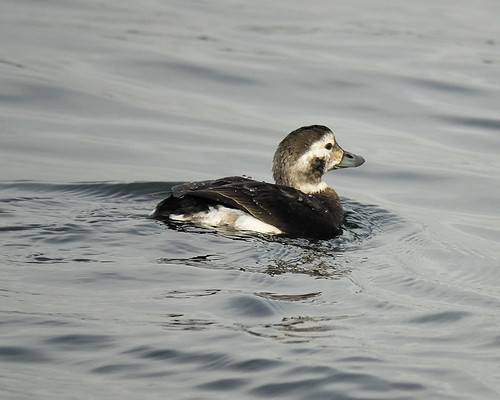tags: Long-tailed Duck, Oldsquaw, Clangula hyemalis, birds, mystery bird, bird ID quiz
[Mystery bird] Long-tailed Duck, formerly known as Oldsquaw, Clangula hyemalis, photographed at Bodega Bay, California. [I will identify this bird for you in 48 hours]
Image: Joseph Kennedy, 23 December 2007 [larger view].
Nikon D200, Kowa 883 telescope with TSN-PZ camera eyepiece 1/750s f/8.0 at 1000.0mm iso400.
Please name at least one field mark that supports your identification.


I'm calling that an adult female long-tailed duck, based mainly on the "white face" and "always white" undertail coverts (Sibley). But in my head I'm actually calling it an oldsquaw, because I'm old-school, and that's how I roll. :-)
Definitely a Long-tailed Duck (Clangula hyemalis) John, but I am not convinced it is a female but rather a juvenile: females have a brown back and in Winter with the head and neck white with a dark crown, whereas juveniles resemble adult females but with a lighter, less distinct cheek patch...
female Long-tailed Duck, Fargo, ND
female Long-tailed Duck, Jones Beach, NY
(unless this is a female mid-molt, but as it's the end of December and the photos I included are early January, I would have thought that if it was indeed a female, the cheek patch would already have been more distinct)
After looking at Madge and Burns, I would still call this a female. It might be a juvenile female, but a juvenile male at this point should be starting to molt in some adult plumage, and should be showing some pink on the bill. This bird doesn't show any.
Paul, I was implying female above but wasn't vey clear with my comment- I think sometimes in the literature (and I must have allowed myself to get caught up in that) there tends to often be differentiation between "males", "females", and "juveniles" as three descriptors rather than gender specific adult or juvenile- I think that this is not an "adult" female but rather a juvenile female which is why I attached examples of adult females that display a more prominent cheek patch- I totally agree that this is not a male.
thanks